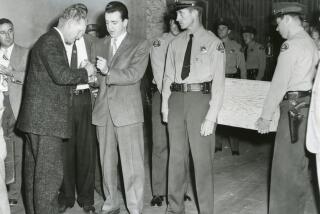‘Watch Stem Rapist’ Fails to Convince Board, Is Denied Parole
SAN LUIS OBISPO — Edward Simon Wein claims that it was a “trademark, not evidence” that sent him to prison 10 years ago on murder and sex-crime convictions.
But the parole board remained unconvinced after reviewing transcripts and documents from two trials--held two decades apart--which showed Wein twice trapped by the “trademark” that prompted police to dub him the “Watch Stem Rapist.”
According to testimony at 1957 and 1976 trials, the most distinctive similarity in each of Wein’s attacks had him pretending to drop his watch stem and assaulting his victim as she got down on the floor to help him find it.
The state Board of Prison Terms denied Wein’s bid for freedom along with those of a dozen other murderers, six from Los Angeles County, in a series of hearings this past week at the California Men’s Colony here.
Viciousness of Crimes
“He was denied his request for parole mainly because of the multiple crimes he committed and the viciousness of those crimes,” said Stephen Blankenship, the board’s executive officer. Wein, now 62, will be given another parole hearing in 1988.
He was sent to prison in 1976 after being convicted of murdering Dorothy George, 52, in her Westchester home on Aug. 8, 1975, and sexually assaulting a 40-year-old restaurant hostess 27 days later in her Palms residence.
In dramatic courtroom confrontations, the prosecutor in the second trial, Robert Altman, now a Superior Court judge, had three of the women Wein attacked in the 1950s identify him to complement the testimony of his victim 20 years later.
Wein spoke briefly on his own behalf at the parole hearing, proclaiming his innocence of the crimes after his release from prison in 1974. He maintained he was convicted on circumstantial evidence and the distinctive “trademark” asserted by the prosecution.
22 Felony Convictions
But Los Angeles County Deputy Dist. Atty. David Coffey pointed out that the sexual assault victim identified Wein and that witnesses placed a man fitting Wein’s description and a car resembling his in the Westchester neighborhood about the time Mrs. George was strangled and dumped in her bathtub.
Wein was convicted on 22 felony counts in the 1957 trial, including rape, robbery, sex perversion and kidnaping where the victim is injured, and was given the death penalty.
But one day before Wein was to be executed, then-Gov. Edmund G. (Pat) Brown commuted his sentence to life “without possibility of parole.” In 1966, Brown further altered Wein’s sentence to life in prison, thus making him eligible for parole.
Wein was released from prison Sept. 16, 1974. In less than a year, he was back behind bars thanks to the long memory of retired Los Angeles Police Department Detective Robert Wright.
Wright, who had ended 30 years of service with LAPD two months earlier, was attending an investigators’ luncheon when he overheard two officers talking about a series of unsolved sex cases where the attacker used the watch stem gambit. Wright passed along his recollection of the Wein case in the 1950s, and that information ultimately led to Wein’s 1975 arrest and conviction.
More to Read
Sign up for Essential California
The most important California stories and recommendations in your inbox every morning.
You may occasionally receive promotional content from the Los Angeles Times.










